Abstract
Intramuscular fat (IMF) content is an important trait closely related to meat quality, which is highly variable among pig breeds from diverse genetic backgrounds. High-throughput sequencing has become a powerful technique for analyzing the whole transcription profiles of organisms. In order to elucidate the molecular mechanism underlying porcine meat quality, we adopted RNA sequencing to detect transcriptome in the longissimus dorsi muscle of Wei pigs (a Chinese indigenous breed) and Yorkshire pigs (a Western lean-type breed) with different IMF content. For the Wei and Yorkshire pig libraries, over 57 and 64 million clean reads were generated by transcriptome sequencing, respectively. A total of 717 differentially expressed genes (DEGs) were identified in our study (false discovery rate < 0.05 and fold change > 2), with 323 up-regulated and 394 down-regulated genes in Wei pigs compared with Yorkshire pigs. Gene Ontology analysis showed that DEGs significantly related to skeletal muscle cell differentiation, phospholipid catabolic process, and extracellular matrix structural constituent. Pathway analysis revealed that DEGs were involved in fatty acid metabolism, steroid biosynthesis, glycerophospholipid metabolism, and protein digestion and absorption. Quantitative real time PCR confirmed the differential expression of 11 selected DEGs in both pig breeds. The results provide useful information to investigate the transcriptional profiling in skeletal muscle of different pig breeds with divergent phenotypes, and several DEGs can be taken as functional candidate genes related to lipid metabolism (ACSL1, FABP3, UCP3 and PDK4) and skeletal muscle development (ASB2, MSTN, ANKRD1 and ANKRD2).




Similar content being viewed by others
References
Cardoso TF, Cánovas A, Canela-Xandri O, González-Prendes R, Amills M, Quintanilla R (2017) RNA-Seq based detection of differentially expressed genes in the skeletal muscle of Duroc pigs with distinct lipid profiles. Sci Rep 7:40005
Chen Z, Zhao XF, Hao Z, Guo XL, Jiang XL, Xu NY (2011) Association of porcine UCP3 gene polymorphisms with fatness traits in a Pietrain × Jinhua F2 population. Afr J Biotechnol 10:3296–3300
Chen W, Fang GF, Wang SD, Wang H, Zeng YQ (2017) Longissimus lumborum muscle transcriptome analysis of Laiwu and Yorkshire pigs differing in intramuscular fat content. Genes Genom 39:759–766
Cho KH, Kim MJ, Jeon GJ, Chung HY (2011) Association of genetic variants for FABP3 gene with back fat thickness and intramuscular fat content in pig. Mol Biol Rep 38:2161–2166
Dai FW, Feng DY, Cao QY, Ye H, Zhang CM, Xia WG, Zuo JJ (2009) Developmental differences in carcass, meat quality and muscle fibre characteristics between the Landrace and a Chinese native pig. S Afr J Anim Sci 39:267–273
Damon M, Wyszynska-Koko J, Vincent A, Hérault F, Lebret B (2012) Comparison of muscle transcriptome between pigs with divergent meat quality phenotypes identifies genes related to muscle metabolism and structure. PLoS ONE 7:e33763
Davey JR, Watt KI, Parker BL, Chaudhuri R, Ryall JG, Cunningham L, Qian HW, Sartorelli V, Sandri M, Chamberlain J, James DE, Gregorevic P (2016) Integrated expression analysis of muscle hypertrophy identifies Asb2 as a negative regulator of muscle mass. JCI Insight 1:e85477
Distel E, Cadoudal T, Collinet M, Park EA, Benelli C, Bortoli S (2017) Early induction of pyruvate dehydrogenase kinase 4 by retinoic acids in adipocytes. Mol Nutr Food Res 61:1600920
Fortin A, Robertson WM, Tong AKW (2005) The eating quality of Canadian pork and its relationship with intramuscular fat. Meat Sci 69:297–305
Han C, Vinsky M, Aldai N, Dugan MER, Mcallister TA, Li C (2013) Association analyses of DNA polymorphisms in bovine SREBP-1, LXRα, FADS1 genes with fatty acid composition in Canadian commercial crossbred beef steers. Meat Sci 93:429–436
Lan J, Lei MG, Zhang YB, Wang JH, Feng XT, Xu DQ, Gui JF, Xiong YZ (2009) Characterization of the porcine differentially expressed PDK4 gene and association with meat quality. Mol Biol Rep 36:2003–2010
Li XP, Kim SW, Choi JS, Lee YM, Lee CK, Choi BH, Kim TH, Choi YII, Kim JJ, Kim KS (2010) Investigation of porcine FABP3 and LEPR gene polymorphisms and mRNA expression for variation in intramuscular fat content. Mol Biol Rep 37:3931–3939
Li QG, Tao Z, Shi LH, Ban DM, Zhang B, Yang YZ, Zhang H, Wu CX (2012) Expression and genome polymorphism of ACSL1 gene in different pig breeds. Mol Biol Rep 39:8787–8792
Li XJ, Zhou J, Liu LQ, Qian K, Wang CL (2016) Identification of genes in longissimus dorsi muscle differentially expressed between Wannanhua and Yorkshire pigs using RNA-sequencing. Anim Genet 47:324–333
Lim KS, Lee KT, Park JE, Chung WH, Jang GW, Choi BH, Hong KC, Kim TH (2017) Identification of differentially expressed genes in longissimus muscle of pigs with high and low intramuscular fat content using RNA sequencing. Anim Genet 48:166–174
Mortazavi A, Williams BA, McCue K, Schaeffer L, Wold B (2008) Mapping and quantifying mammalian transcriptomes by RNA-Seq. Nat Methods 5:621–628
Niemsiri V, Wang XB, Pirim D, Radwan ZH, Bunker CH, Barmada MM, Kamboh MI, Demirci FY (2015) Genetic contribution of SCARB1 variants to lipid traits in African Blacks: a candidate gene association study. BMC Med Genet 16:106
Óvilo C, Benítez R, Fernández A, Núñez Y, Ayuso M, Fernández AI, Rodríguez C, Isabel B, Rey AI, López-Bote C, Silió L (2014) Longissimus dorsi transcriptome analysis of purebred and crossbred Iberian pigs differing in muscle characteristics. BMC Genom 15:413
Pietruszka A, Jacyno E, Kawecka M, Biel W (2015) The relation between intramuscular fat level in the longissimus muscle and the quality of pig carcasses and meat. Ann Anim Sci 15:1031–1041
Ponsuksili S, Murani E, Phatsara C, Schwerin M, Schellander K, Wimmers K (2009) Porcine muscle sensory attributes associate with major changes in gene networks involving CAPZB, ANKRD1, and CTBP2. Funct Integr Genom 9:455–471
Ropka-Molik K, Żukowski K, Eckert R, Piórkowska K, Oczkowicz M, Gurgul A, Szmatoła T (2015) Whole transcriptome analysis of the porcine muscle tissue of breeds differing in muscularity and meat quality traits. Livest Sci 182:93–100
Schwab CR, Baas TJ, Stalder KJ, Nettleton D (2009) Results from six generations of selection for intramuscular fat in Duroc swine using real-time ultrasound. I. Direct and correlated phenotypic responses to selection. J Anim Sci 87:2774–2780
Serão NVL, Veroneze R, Ribeiro AMF, Verardo LL, Braccini Neto J, Gasparino E, Campos CF, Lopes PS, Guimarães SEF (2011) Candidate gene expression and intramuscular fat content in pigs. J Anim Breed Genet 128:28–34
Sun L, Dong XJ, Fan B, Liu B (2011) The association of ANKRD2 with loin depth and muscle firmness in pigs. J Anim Vet Adv 10:1462–1468
Thomas M, Langly B, Berry C, Sharma M, Kirk S, Bass J, Kambadur R (2000) Myostatin, a negative regulator of muscle growth, functions by inhibiting myoblast proliferation. J Biol Chem 275:40235–40243
Trapnell C, Pachter L, Salzberg SL (2009) TopHat: discovering splice junctions with RNA-Seq. Bioinformatics 25:1105–1111
Trapnell C, Williams BA, Pertea G, Mortazavi A, Kwan G, van Baren MJ, Salzberg SL, Wold BJ, Pachter L (2010) Transcript assembly and quantification by RNA-Seq reveals unannotated transcripts and isoform switching during cell differentiation. Nat Biotechnol 28:511–515
Tyra M, ŻAk G (2012) Analysis of relationships between fattening and slaughter performance of pigs and the level of intramuscular fat (IMF) in longissimus dorsi muscle. Ann Anim Sci 12:169–178
Wang S, Subramaniam A, Cawthorne MA, Clapham JC (2003) Increased fatty acid oxidation in transgenic mice overexpressing UCP3 in skeletal muscle. Diabetes Obes Metab 5:295–301
Wang LJ, Lei MG, Xiong YZ (2011) Molecular characterization and different expression patterns of the muscle ankyrin repeat protein (MARP) family during porcine skeletal muscle development in vitro and in vivo. Anim Biotechnol 22:87–99
Wang ZX, Li QG, Chamba YZ, Zhang B, Shang P, Zhang H, Wu CX (2015) Identification of genes related to growth and lipid deposition from transcriptome profiles of pig muscle tissue. PLoS ONE 10:e0141138
Wheeler TL, Shackelford SD, Koohmaraie M (2000) Variation in proteolysis, sarcomere length, collagen content, and tenderness among major pork muscles. J Anim Sci 78:958–965
Wickramasinghe S, Cánovas A, Rincón G, Medrano JF (2014) RNA-sequencing: a tool to explore new frontiers in animal genetics. Livest Sci 166:206–216
Widmann P, Nuernberg K, Kuehn C, Weikard R (2011) Association of an ACSL1 gene variant with polyunsaturated fatty acids in bovine skeletal muscle. BMC Genet 12:96
Xue W, Wang W, Jin B, Zhang X, Xu X (2015) Association of the ADRB3, FABP3, LIPE, and LPL gene polymorphisms with pig intramuscular fat content and fatty acid composition. Czech J Anim Sci 60:60–66
Yi B, Wang JG, Wang S, Yuan DL, Sun JZ, Li ZL, Mao YP, Hou Q, Liu WQ (2014) Overexpression of Banna mini-pig inbred line fatty acid binding protein 3 promotes adipogenesis in 3T3-L1 preadipocytes. Cell Biol Int 38:918–923
Yu KF, Shu G, Yuan FF, Zhu XT, Gao P, Wang SB, Wang LN, Xi QY, Zhang SQ, Zhang YL, Li Y, Wu TS, Yuan L, Jiang QY (2013) Fatty acid and transcriptome profiling of longissimus dorsi muscles between pig breeds differing in meat quality. Int J Biol Sci 9:108–118
Zeng Z, Chen R, Liu C, Yang H, Chen C, Huang L (2014) Evaluation of the causality of the low-density lipoprotein receptor gene (LDLR) for serum lipids in pigs. Anim Genet 45:665–673
Zhan TZ, Poppelreuther M, Ehehalt R, Füllekrug J (2012) Overexpressed FATP1, ACSVL4/FATP4 and ACSL1 increase the cellular fatty acid uptake of 3T3-L1 adipocytes but are localized on intracellular membranes. PLoS ONE 7:e45087
Zhang ZQ, Chen HZ, Yang RF, Zhang R, Jia YY, Xi Y, Liu DP, Liang CC (2010) Regulation of acyl-coenzyme A: cholesterol acyltransferase 2 expression by saturated fatty acids. Chin Med Sci J 25:222–227
Zhao SM, Ren LJ, Chen L, Zhang X, Cheng ML, Li WZ, Zhang YY, Gao SZ (2009) Differential expression of lipid metabolism related genes in porcine muscle tissue leading to different intramuscular fat deposition. Lipids 44:1029–1037
Zhao X, Mo DL, Li AN, Gong W, Xiao SQ, Zhang Y, Qin LM, Niu YN, Guo YX, Liu XH, Cong PQ, He ZY, Wang C, Li JQ, Chen YS (2011) Comparative analyses by sequencing of transcriptomes during skeletal muscle development between pig breeds differing in muscle growth rate and fatness. PLoS ONE 6:e19774
Acknowledgements
This work was supported by the Provincial Natural Science Research Project of Anhui Colleges (KJ2016A180 and KJ2017ZD43), the Anhui Provincial Science and Technology Major Special Project (16030701066), the Anhui Provincial Science and Technology Plan Project (1704a07020093), and Open Fund of Anhui Province Key Laboratory of Local Livestock and Poultry Genetical Resource Conservation and Breeding (AKLGRCB2017012).
Author information
Authors and Affiliations
Corresponding authors
Ethics declarations
Conflict of interest
Jingen Xu, Chonglong Wang, Erhui Jin, Youfang Gu, Shenghe Li and Qinggang Li declare that they have no conflict of interest.
Ethical approval
This work was approved by the Animal Welfare and Use Committee of Anhui Science and Technology University.
Electronic supplementary material
Below is the link to the electronic supplementary material.
Rights and permissions
About this article
Cite this article
Xu, J., Wang, C., Jin, E. et al. Identification of differentially expressed genes in longissimus dorsi muscle between Wei and Yorkshire pigs using RNA sequencing. Genes Genom 40, 413–421 (2018). https://doi.org/10.1007/s13258-017-0643-3
Received:
Accepted:
Published:
Issue Date:
DOI: https://doi.org/10.1007/s13258-017-0643-3




